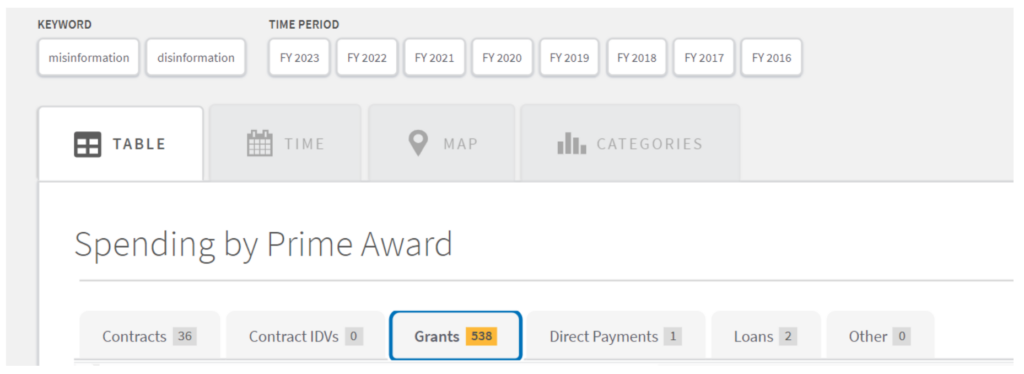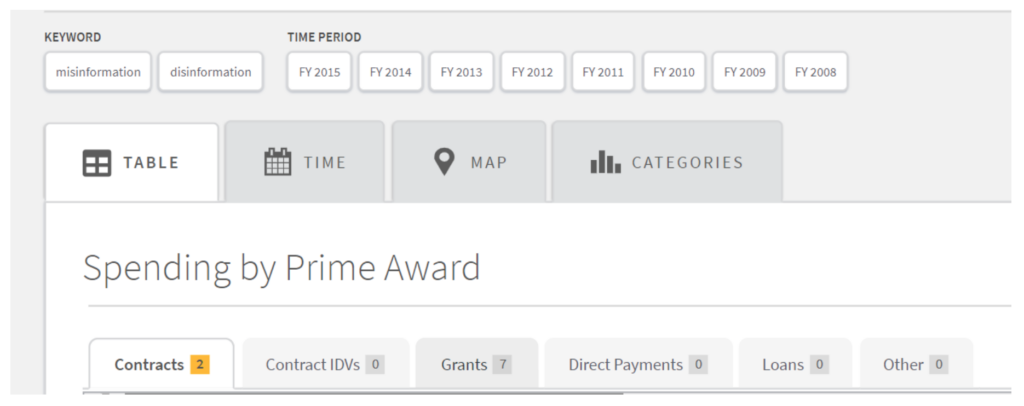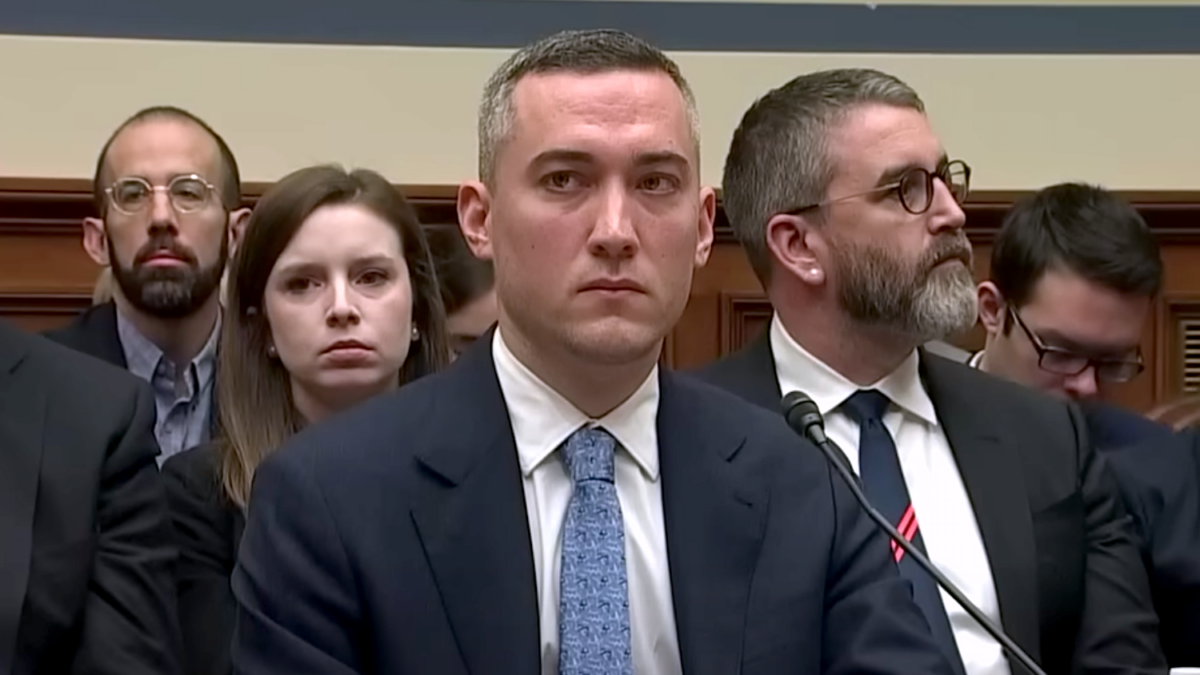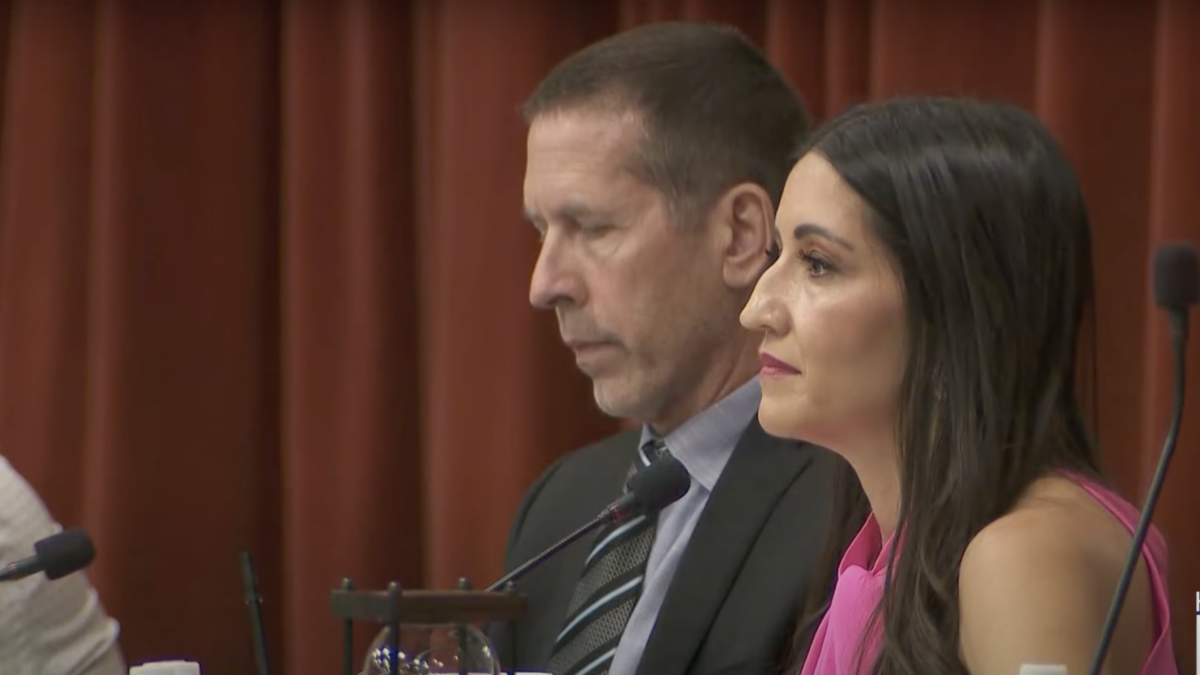While the “Twitter Files” and the Washington Examiner’s coverage of the Global Disinformation Index have revealed an expansive Censorship Complex that seeks to silence Americans for money, politics, ideology, and power, much still needs to be unraveled.
A search of government contracts and grants for the eight fiscal years from 2016 through today for the keywords “misinformation” or “disinformation” reveals 538 federal government grants and 36 contracts were awarded to a wide range of academic institutions and non-governmental organizations.

Mapping out the connections among the various award recipients, the government, and the pro-censorship left will require more work. But this simple snapshot confirms taxpayers’ money is funding the expansion of the Censorship Complex, as the prior eight fiscal years, from 2008 to 2015, reveal the federal government awarded only two federal contracts and seven federal grants for “disinformation” or “misinformation” research.

Likewise, an initial investigation into the nonprofits and academic institutions mentioned in the “Twitter Files” reveals government grants, donations from other liberal nonprofits, and money from leftist billionaires funded the expansion of the Censorship Complex. Research also shows the non-governmental organizations pushing the disinformation narrative are uniformly directed and run by former government employees, left-wing media types, and left-leaning or anti-Trump individuals.
Alliance Securing Democracy
Of the think tanks identified in Twitter communications, Alliance Securing Democracy (ASD) might be the most notorious thanks to Matt Taibbi’s exposé on ASD’s Hamilton 68 dashboard.
Devised by former FBI agent Clint Watts and launched in August of 2017, Hamilton 68 proclaimed its digital dashboard an aid to “help ordinary people, journalists, and other analysts identify Russian messaging themes and detect active disinformation or attack campaigns as soon as they begin.” Based on some 644 accounts that Hamilton 68 claimed it had “selected for their relationship to Russian-sponsored influence and disinformation campaigns,” ASD maintained its dashboard allowed users to track online Russian influence.
The problem is, as Taibbi wrote: “The Twitter Files expose Hamilton 68 as a sham.”
Apparently unbeknownst to ASD, Twitter had reverse-engineered how Hamilton 68 supposedly tracked online Russian influence and found “No evidence to support the statement that the dashboard is a finger on the pulse of Russian information ops.” The entire methodology was flawed.
Yet ASD played a key role in the push to censor speech as supposed “disinformation,” with the dashboard serving as “the source of hundreds if not thousands of mainstream print and TV news stories in the Trump years” by “virtually every major news organization.” In addition to the media spreading disinformation about disinformation, Watts testified before Congress, telling senators that the Hamilton 68 dashboard provided the means for the U.S. government “to have an understanding of what Russia is doing in social media.”
Watts further revealed in his testimony to the Senate Committee on Commerce, Science, and Transportation, that he “tried to provide to the U.S. government directly through multiple agencies” the Hamilton 68 information, telling the lawmakers they should “want to equip our intelligence agencies, our law enforcement agencies, and the Department of Defense with just an understanding … of what Russian active measures are doing around the world.”
Whether any of those “multiple agencies” relied on the inaccurate information included on the Hamilton 68 dashboard is unclear.
Members of the House and Senate did rely on Hamilton 68, however. As I reported earlier this month: “Rep. Adam Schiff and Sens. Dianne Feinstein, Richard Blumenthal, and Sheldon Whitehouse, among others, not only pushed the unfounded claims that Russian bots were behind the trending hashtags, but they also demanded that Twitter and other tech companies investigate and stop such supposed interference.” Democrats pushed this false narrative even when Twitter executives warned staffers that the Russian-interference story didn’t stand.
In addition to Watts, the ASD advisory council includes a cornucopia of former government bigwigs from Democrat administrations: Michael McFaul, a former ambassador to Russia in the Obama administration; Michael Morell, former acting director of the Central Intelligence Agency under President Barack Obama; John Podesta, former chair of Hillary for America and an official in the Clinton and Obama White Houses; and Jake Sullivan, former deputy chief of staff to former Secretary of State Hillary Clinton and a key adviser for both Clinton and Obama during their general elections.
Laura Thornton, who previously worked at the National Democratic Institute, a nonprofit loosely affiliated with the Democrat Party, currently oversees ASD. And Rachael Dean Wilson serves as the managing director for ASD. Wilson previously worked for the late Sen. John McCain for six years, serving as his communications director and adviser to his 2016 re-election campaign.
German Marshall Fund
According to its website, ASD is a project of the German Marshall Fund, which “is heavily funded by the American, German, and Swedish governments.” The fund has also received grants from eBay founder Pierre Omidyar’s Democracy Fund, and George Soros’ Open Society Foundation. The ASD likewise receives financing from left-leaning foundations, such as the Craigslist founder’s Craig Newmark Philanthropies.
The Election Integrity Partnership
Another prominent organization the “Twitter Files” revealed as pushing for censorship — including multiple censorship requests flowing through that group to the tech giant — is the Election Integrity Partnership, which is run out of Stanford’s Internet Observatory.
Stanford’s Internet Observatory launched on June 6, 2019, to “focus on the misuse of social media,” and within two years, the project grew from an initial team of three to a full-time team of 10 assisted by some 76 student research assistants. In 2020, Stanford announced the creation of the Election Integrity Partnership, which “brought together misinformation researchers” from across four organizations: Stanford Internet Observatory, the University of Washington’s Center for an Informed Public, Graphika, and the Atlantic Council’s Digital Forensic Research Lab.
As a private institution, Stanford University is not funded directly with tax dollars, but it receives millions in government grants. Private grants also flow into the California university and directly fund the Election Integrity Partnership, including money from the same foundations that funded the nonprofit behind Hamilton 68, such as money from the Craigslist and eBay founders.
Atlantic Council Project
Further research on the other members of the Election Integrity Partnership reveals the Atlantic Council receives donations and federal grants, including from Facebook, Google, and the U.S. Department of State. And as will be shown shortly, the Atlantic Council is also connected to the Global Disinformation Index.
Graphika
Another member of the Election Integrity Partnership, Graphika, describes itself as a “network analysis company that examines how ideas and influence spread online.” Graphika’s chief innovation officer, Camille Francois “leads the company’s work to detect and mitigate disinformation, media manipulation and harassment.” Francois was previously the principal researcher at Google’s Jigsaw unit.
According to CNBC, one of Francois’ first projects at Graphika was a “secretive” assignment for the U.S. Senate Select Committee on Intelligence. Working with a team of researchers from Oxford University, Graphika analyzed data provided by social media firms to the Senate Intelligence Committee to assess Russia’s exploitation of “the tools and platform of Facebook, Instagram, Twitter, and YouTube to impact U.S. users” and influence elections.
As a private organization, Graphika’s funding details remain obscure, but in congressional testimony, Dr. Vlad Barash he “oversee[s] our work with DARPA and with our colleagues from leading academic institutions on developing and applying cutting edge methods and algorithms for detecting the manipulation of 21st Century networked communications.”
According to government data, Graphika — also known as Octant Data, LLC and Morningside Analytics — received numerous Department of Defense contracts. Additionally, Graphika received a $3 million grant from the DOD for a 2021-2022 research project related to “Research on Cross-Platform Detection to Counter Malign Influence.”
Graphika received a second nearly $2 million grant from the DOD for “research on Co-Citation Network Mapping.” The organization had previously researched “network mapping,” or the tracking of how Covid “disinformation” spreads through social media.
The Center for Internet Security
The “Twitter Files” also made mention of the Center for Internet Security. In 2018, that nonprofit launched the Elections Infrastructure Information Sharing and Analysis Center (EI-ISAC), which “it claims supports the cybersecurity needs of election offices.” As part of those efforts, the Center for Internet Security crafted a one-page document for election officials, with directions for reporting misinformation or disinformation to the EI-ISAC. The federal U.S. Elections Commission would link to the CIS flyer on its government webpage.
The CIS flyer directed election workers to submit supposed “misinformation or disinformation” to the EI-ISAC, stating it would then “forward it to our partners at The Cyber and Infrastructure Security Agency (CISA) at the Department of Homeland Security (DHS).” CISA would then “submit it to the relevant social media platform(s) for review,” including Facebook, Instagram, Twitter, Google, TikTok, Nextdoor, and Snapchat.
CIS further said it would share reports of misinformation or disinformation with the Election Integrity Partnership at Stanford University. And from the “Twitter Files,” we see examples of the Election Integrity Partnership providing the Twitter team CIS’s reports of misinformation or disinformation, prompting the censorship of speech.
The Center for Internet Security is heavily funded by government grants. According to Influence Watch, the nonprofit “provides cyber-security consulting services to local, state, and federal governments,” and has been awarded $115 million in federal grants by the Department of Homeland Security and Department of Defense since 2010. It has received $3.6 million in cybersecurity contracts from numerous federal agencies, according to its webpage, and a $290,000 grant from the eBay founder’s left-leaning Democracy Fund.
The president and CEO of the Center for Internet Security is another former high-level government adviser, John Gilligan. Gilligan “previously served in senior advisory positions in intelligence and security for the United States Airforce, Department of Energy, and White House Cyber Security Commission under the Obama administration.”
Clemson University
Other emails released as part of the “Twitter Files” reveal Clemson University’s role in the push for censorship at Twitter. And as was the case with Hamilton 68’s dashboard, Twitter’s team had concerns about Clemson’s disinformation research.
In one email, Twitter noted that Clemson’s center had asked the tech company to review its “findings regarding the latest list of accounts.” Internal communications show the Twitter team noting that while they saw “some inauthentic behaviors,” they “were unable to attribute the accounts to the IRA,” the Russian “troll” farm.
After noting that Twitter had already shared information with Clemson researchers, the tech giant’s head of safety, Yoel Roth, sent another email. “There is nothing new we’ll learn here, analytically,” Roth said. “We’re not going to attribute these accounts to Russia … absent some solid technical intel (which Clemson have not ever been able to provide).”
Defending Democracy Together
Clemson’s research was used by another group joining the “disinformation” trend, Defending Democracy Together (DDT). In 2018, DDT launched the RussiaTweets.com project to supposedly provide “the evidence of Russian interference in American politics.”
This evidence, according to DDT, came from a list of tweets “compiled and published by Professors Darren Linvill and Patrick Warren,” which purportedly all came from the Russian troll factory, Internet Research Agency (IRA). Both Linvill and Warren hail from Clemson University, raising the question of whether it was the list they provided to Defending Democracy Together that Twitter executives “were unable to attribute” to the IRA.
Defending Democracy Together was founded in 2018, and its leadership consists of Never Trumpers, William “Bill” Kristol, Mona Charen, and Charlie Sykes, as well as DDT’s co-founder and director Sarah Longwell, who has promoted advertisements “to advocate against the policies of the Trump administration and to weaken public support for the Trump presidency.”
Funding for DDT, according to Influence Watch, includes money from left-wing mega-donor and eBay founder Pierre Omidyar through Democracy Fund Voice and from the Hopewell Fund, which is “part of a $600 million network of left-wing funding nonprofits managed by Arabella Advisors in Washington, D.C.” Additionally, OpenSecrets reported that DDT was “the biggest ‘dark money’ spender of 2020,” with DDT spending “$15.4 million in ‘dark money’ during the 2020 election cycle on supporting presidential candidate Joe Biden and opposing former President Donald Trump for reelection.”
Other Academic Institutes
While Stanford and Clemson were the two main universities identified in the “Twitter Files,” Clemson’s Media Forensics Hub webpage identifies members of its “Disinformation Working Group,” revealing academia’s involvement in the Censorship Complex spans much further. It includes: the Massachusetts Institute of Technology’s Lincoln Lab, the University of Illinois Urbana-Champaign, Duke University, Bowdoin College, the University of South Carolina, Vanderbilt University, Georgetown University, and Wilfrid Laurier, a Canadian University supported by a Facebook grant.
The University of Buffalo, Lehigh University, and Northeastern University are likewise involved in the disinformation project, with a Clemson News release revealing that faculty at those universities, along with researchers at the University of Illinois Urbana-Champaign, launched a project titled “Disinformation Range to Improve User Awareness and Resilience to Online Disinformation.” The government, through a $750,000 grant from the National Science Foundation, is supporting those efforts.
The Aspen Institute
The Aspen Institute is also entwined in the Censorship Complex, having hosted in the fall of 2020 “a series of off-the-record briefings to help prepare every major US newsroom and tech platform for potential hack-and-leak operations and a contested post-election environment.” One of the briefings involved a tabletop exercise facilitated by Aspen’s Garrett Graff that posed a hack-and-leak October surprise involving Hunter Biden.
Twitter’s Yoel Roth attended that event just two weeks before the New York Post broke the Hunter Biden laptop story. And soon after that story broke, Graff and his Aspen Institute colleague Vivian Schiller took to Twitter to frame the story as “crap” and “nonsense.” Schiller’s former jobs include CEO at NPR, head of news at Twitter, general manager at The New York Times, and chief digital officer at NBC News.
Soon after Graff and Schiller pushed the Hunter Biden story as misinformation, Twitter blocked the Post’s story and froze the conservative outlet’s account, even though internal communications revealed the Post had not violated Twitter’s terms of service. Despite its extensive coordination with the FBI to prepare to combat foreign election interference, Twitter didn’t ask the bureau if the scandal was Russian disinformation. Instead, Twitter representatives testified to Congress that the company “relied on the tweets of supposed experts, making the tech giant’s decision to censor the Post’s story even more outrageous.”
After the Post broke the Biden family pay-to-play scandal, several left-leaning “journalists” spent the day speaking of “misinformation,” while uniformly ignoring the substance of the story. One must wonder how many of those so-called journalists had attended Aspen’s training session.
Since then, Aspen has expanded its focus on disinformation and misinformation, launching a “Commission on Information Disorder” to develop what the institute calls “actionable public-private responses to the disinformation crisis.”
The Global Disinformation Index
Another nonprofit, the Global Disinformation Index, has already begun pushing an “actionable response to the disinformation crisis,” by pressuring advertisers to dump news outlets based on GDI’s view of their “disinformation risk.” However, as the Washington Examiner revealed in Gabe Kaminsky’s investigative series, the GDI’s December 2022 report, prepared in partnership with the University of Texas-Austin’s Global Disinformation Lab, brands only conservative outlets as the top “riskiest.” Conversely, the “least risky” outlets all lean left, other than The Wall Street Journal, and are also the same outlets that got the most significant news stories of the last decade wrong.
Like the “disinformation” nonprofits named in the “Twitter Files,” GDI has received federal grants and is connected to other left-leaning nonprofits and individuals seeking to censor speech. Its advisers likewise hew left, such as “journalist” Anne Applebaum, who said Hunter Biden’s foreign business dealings were not interesting, and Finn Heinrich of the leftist George Soros’ Open Society group.
The composition of GDI’s “advisory panel” is also noteworthy because the same individuals guiding GDI’s mission to starve conservative sites of advertising dollars are connected to three of the organizations behind the Election Integrity Partnership’s push for censorship at Twitter. That fact would be difficult to discover today, though, as GDI scrubbed its “advisory panel” section of its homepage after the blacklist scandal broke.
According to the archived GDI homepage, advisory panel members include Ben Nimmo, the global lead at Meta; Franziska Roesner, a University of Washington professor; and Camille Francois of Niantic. Nimmo was a founding member of the Atlantic Council’s Digital Forensic Research Lab (DFRLab) and a senior fellow for that lab. He was also “the first director of investigations at Graphika.” Francois also serves as the chair of Graphika’s advisory board and is identified on Graphika’s webpage as its chief innovation officer. Roesner is a faculty member at the University of Washington’s Center for an Informed Public.
Together then, three of the four organizations that partnered with Stanford to run the Election Integrity Partnership, which pushed Twitter to censor speech in advance of the 2020 election, were also connected to the Global Disinformation Index.
Global Engagement Center
A strong connection also exists between GDI and the U.S. government through an arm of the State Department, the Global Engagement Center, which has also made several appearances in the “Twitter Files.”
The Global Engagement Center, which proclaims itself “a data-driven body leading U.S. interagency efforts in proactively addressing foreign adversaries’ attempts to undermine U.S. interests using disinformation and propaganda,” awarded the Global Disinformation Index a $100,000 grant as part of the U.S-Paris Tech Challenge. The State Department sponsored that “Tech Challenge” in “collaboration” with, among others, the Atlantic Council’s Digital Forensic Research Lab, Park Advisors, and Disinfo Cloud. According to a State Department spokesman, the Global Engagement Center began funding Disinfo Cloud in 2018 and also awarded approximately $300,000 to Park Advisors to manage Disinfo Coud to fight “disinformation, terrorism, violent extremism, hate speech.”
The “Twitter Files” revealed that, in addition to funding private organizations pushing for censorship, the State Department’s Global Disinformation Center attempted to insert itself into Twitter’s review and censorship process. When those efforts failed, the Global Disinformation Center pressed its unsupported claims of disinformation to the media.
Additional research is needed to understand the full scope of the Global Engagement Center’s role in the Censorship Complex, but what little is known now suggests the State Department provides load-bearing support for the project. A recent report from the Foundation for Freedom Online also exposes the National Science Foundation as a key funder in “the science of censorship.”
While federal funding is not solely responsible for the rapid expansion of the Censorship Complex, it is the most troubling because our government is using our money to censor our speech.









